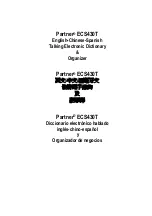
Setup Mode
Riffs
7-65
arpeggiator’s
downbeat
will
occur.
With
RelSynTyp
set
to
AnyBeat
,
if
there
is
already
a
something
playing
to
sync
to,
the
riff
will
wait
only
until
the
next
beat
before
stopping
when
released.
Depending
on
when
you
release
the
riff
it
will
stop
in
sync
with
a
beat,
but
it
may
be
on
an
upbeat
or
a
downbeat.
With
RelSynTyp
set
to
DownBeatWait
,
the
riff
will
wait
for
the
downbeat
of
the
next
measure
to
stop
when
released.
The
difference
from
DownBeat
is
that
if
there
is
nothing
playing
to
sync
to,
the
riff
wont
stop
when
released.
If
another
riff
is
already
running,
DownBeatWait
behaves
just
like
DownBeat
.
With
RelSynTyp
set
to
AnyBeatWait
,
if
there
is
already
a
something
playing
to
sync
to,
the
riff
will
wait
for
the
next
beat
before
releasing.
The
difference
from
AnyBeat
is
that
if
there
is
nothing
playing
to
sync
to,
this
riff
will
not
stop
when
released.
This
can
be
useful
if
you
want
to
stop
a
riff
in
sync
only
when
another
riff
is
playing.
If
something
is
already
playing
to
sync
to,
AnyBeatWait
behaves
just
like
AnyBeat.
With
RelSynTyp
set
to
Loop
,
if
there
is
already
a
riff
or
song
playing
to
sync
to,
the
current
riff
will
wait
for
the
playing
riff
or
song
to
restart
its
loop
(if
it
is
looped)
before
stopping
when
released
(see
Loop
on page 7
‐
62
for
looping
riffs,
and
Loop
on page 12
‐
11
for
looping
songs.)
This
way
you
can
release
the
riff
to
stop
ahead
of
time,
and
have
it
stop
in
sync
at
the
start
of
the
playing
riff
or
song’s
loop.
With
RelSynTyp
set
to
Stop
,
if
there
is
already
something
playing
to
sync
to,
the
current
riff
will
wait
for
what
is
playing
to
stop
before
releasing.
This
way
you
can
trigger
the
current
riff
to
release
ahead
of
time,
and
have
it
stop
in
sync
at
the
release
(stopping)
of
the
riff,
arpeggiator,
or
song
that
you
are
syncing
to.
With
RelSynTyp
set
to
StartWait
,
if
there
is
nothing
playing
to
sync
to,
the
current
riff
will
wait
for
something
it
can
sync
to
to
begin
playing
first
before
releasing.
This
is
similar
to
DownBeatWait,
but
it
will
only
release
the
riff
the
first
time
that
whatever
it
is
syncing
to
starts.
This
way
you
can
trigger
the
riff
to
stop
ahead
of
time,
and
have
it
stop
in
sync
at
the
start
of
the
riff,
arpeggiator,
or
song
that
you
are
syncing
to.
If
you
restart
the
riff
and
try
to
release
it
again
while
the
thing
you
are
syncing
to
is
already
playing,
StartWait
will
not
stop
the
riff.
With
RelSynTyp
set
to
LoopWait
,
if
there
is
already
a
riff
or
song
playing
to
sync
to,
the
current
riff
will
wait
for
the
playing
riff
or
song
to
restart
its
loop
(if
it
is
looped)
before
stopping
(see
Loop
on page 7
‐
62
for
looping
riffs,
and
Loop
on page 12
‐
11
for
looping
songs.)
This
way
you
can
trigger
the
riff
to
stop
ahead
of
time,
and
have
it
stop
in
sync
at
the
start
of
the
playing
riff
or
song’s
loop.
The
difference
from
Loop
is
that
if
there
is
nothing
playing
to
sync
to,
the
riff
will
not
stop
when
released.
If
the
riff
or
song
that
you
are
syncing
to
is
already
running,
LoopWait
behaves
just
like
Loop
.
With
RelSynTyp
set
to
StopWait
,
if
there
is
already
something
playing
to
sync
to,
the
current
riff
will
wait
for
what
is
playing
to
stop
before
releasing.
This
way
you
can
trigger
the
riff
to
stop
ahead
of
time,
and
have
it
start
in
sync
at
the
release
(stopping)
of
the
riff,
arpeggiator,
or
song
that
you
are
syncing
to.
The
difference
from
Stop
is
that
if
there
is
nothing
playing
to
sync
to,
the
riff
will
not
stop
when
released.
If
the
riff
or
song
that
you
are
syncing
to
is
already
running,
StopWait
behaves
just
like
Stop
.
Note:
For
all
RelSynTyp
settings
except
Stop,
StartWait
and
StopWait
,
a
riff
can
sync
its
release
with
its
self.
For
example,
you
could
use
riff
1
and
sync
it
to
its
self
by
setting
Riff
1
for
the
RelSynZn
parameter.
Then,
if
you
set
DownBeat
for
the
RelSynTyp
parameter,
when
released
the
riff
would
always
wait
until
its
next
downbeat
to
stop.
Summary of Contents for PC3K6
Page 24: ...1 6 Introduction Options...
Page 50: ...4 4 The Operating Modes Using the Modes...
Page 58: ...5 8 Editing Conventions Special Button Functions...
Page 130: ...6 72 Program Mode Programming Tips...
Page 202: ...7 72 Setup Mode Recording A Setup To Song Mode...
Page 206: ...8 4 Quick Access Mode The QA Editor...
Page 232: ...9 26 Effects Mono Algorithms...
Page 268: ...11 18 Master Mode Preview Sample PRVIEW...
Page 302: ...12 34 Song Mode and the Song Editor Song Editor The EVENT Page...
Page 328: ...14 14 Keymap and Sample Editing Editing Samples...
Page 334: ...B 4...
Page 370: ...D 32 PC3K Objects V 1 31 Effect Chains...
Page 372: ...E 2 PC3K Legacy File Conversion Object Types and Conversion Details...















































